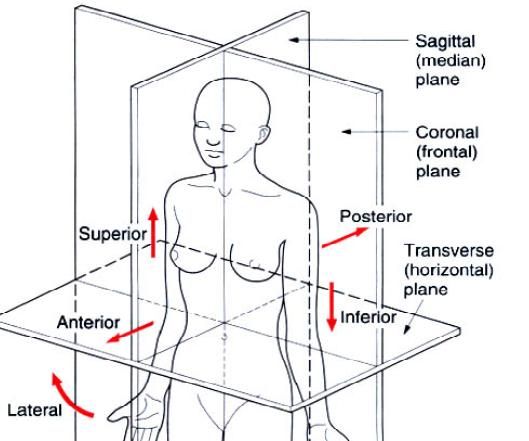UPPER PART
LOWER PART
The following is a list of more commonly used
terms which describe the position of anatomical structures:
Anterior(ventral) – to the front or in front, e.g. the patella
lies anterior to the knee joint.
Posterior(dorsal) – to the rear or behind, e.g. gluteus maximus
lies posterior to the hip joint(ventral and dorsal are used more commonly in
four-legged animals).
Superior(cephalic) – above, e.g. the head is superior to the
trunk.
Inferior(caudal) – below, e.g. the knee is inferior to the hip.
Cephalic(the
head) caudal(the tail) – may
be used in relation to the trunk.
Lateral – away from the median plane or midline, e.g.
the little toe lies lateral to the big toe.
Medial – towards the median plane or midline, e.g.
the little finger lies medial to the thumb.
Distal – away from the trunk or root of the limb,
e.g. the foot is distal to the knee.
Proximal
– close to the trunk or root
of the limb, e.g. the wrist is proximal to the hand.
Superficial – close to the surface of the body or skin,
e.g. the ulnar nerve passes superficial to the flexor retinaculum of the wrist.
Deep – away from the body surface or skin, e.g. the
tendon of tibialis posterior passes deep to the flexor retinaculum is the
ankle.
To facilitate the understanding of the relation
of structures one to another and the movement of one segment with respect to
another, imaginary reference plans pass through the body in such a way that
they are mutually perpendicular to each other(see figure above). Passing
through the body from front to back and dividing it into two symmetrical right
and left halves is the sagittal(median)
plane. Any plane parallel to this is also known as a sagittal(paramedian) plane.
A plane passing through the body from top to
bottom and lying at right angles to the sagittal plane is the coronal(frontal) plane. This divides
the body into anterior and posterior parts. All planes that divide the body in
this way are known as the coronal planes.
Finally, a plane passing through the body at right angles dividing it into
upper and lower parts is known as a transverse(horizontal)
plane. A whole family of parallel transverse planes exist, it is therefore
usual when presenting a particular transverse section to specify the level at
which it is taken. This may be done by specifying the vertebral level or the
position within the limb, e.g. C6 or midshaft or humerus respectively.
Within an each plane a single axis can be
identified, usually an association with a particular joint, about which
movement takes place. An anteroposteriorly directed axis in the sagittal(or a paramedian) plane allows
movement in a coronal plane. Similarly, a vertical axis in a coronal plane allows movement in a
transverse plane. Lastly a transverse(right to the left) axis in a coronal plane provides movement in a
paramedian plane.
By arranging that these various axes intersect
at the centre of joints, the movement possible at the joint can be broken down
into simple components. It also becomes easier to understand how specific
muscle groups produce particular movements, as well as determining the
resultant movement of combined muscle actions.











0 коментара:
Постави коментар